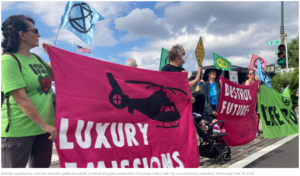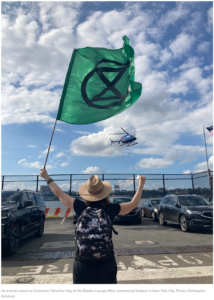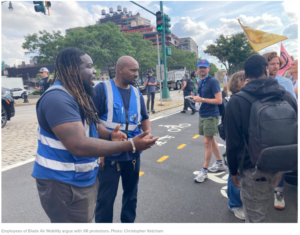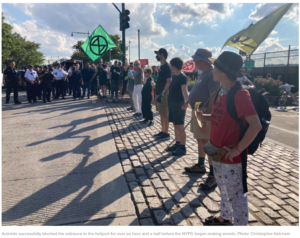Extinction Rebellion takes on heliports in Manhattan during a week of climate action.
 This post, written by renowned eco-journalist Christopher Ketcham and commissioned by and published in Truthdig on Sept. 15, describes an action I helped organize and participated in, two days earlier. We repost it here, with permission, because it highlights a rare climate protest that targets fossil fuel “demand” rather than supply. And not just ordinary fuel usage but an egregiously selfish and exclusive one: helicopter travel.
This post, written by renowned eco-journalist Christopher Ketcham and commissioned by and published in Truthdig on Sept. 15, describes an action I helped organize and participated in, two days earlier. We repost it here, with permission, because it highlights a rare climate protest that targets fossil fuel “demand” rather than supply. And not just ordinary fuel usage but an egregiously selfish and exclusive one: helicopter travel.
“Helicopters are a pestilence to New Yorkers and a rotten pinnacle of an economic system that places decadent pleasure over planetary survival,” I declaimed in the XR press release. True externality pricing would shut down the vast majority of helicopter transportation. Absent, or alongside that, last week’s direct action was an attention-getting way of connecting the climate crisis to luxury emissions.
— Charles Komanoff, Sept. 20, 2023.
* * * * * * * *
The Extinction Rebellionists mustered south of the heliport on the west side of Manhattan at around 2 p.m., just as the sun emerged following a flurry of rain. It was hot when the crowd of 40 people moved as one to stop the howling machines based at Blade Lounge West, a commercial heliport on 30th Street along the Hudson River Greenway. The outsized carbon footprint of those who used the heliport was “obscene,” said the organizers. The afternoon’s goal was to make as much trouble for its operations as possible.
One of the organizers of the action, a 75-year-old energy economist named Charles Komanoff, was prepared to be arrested. He told me he had been feeling unsteady that morning, jittery and fearful, as he handed me his rain slicker and water bottle and backpack to hold.
Months earlier, he had explained his reasons for wanting to shut down helicopter traffic in his native city. “New Yorkers hate helicopters,” Komanoff wrote in an email to Extinction Rebellionists:
Tourist helicopters, Hamptons helicopters…. They hate the noise, the fumes… the arrogance, the power to pollute, the power to act as lords. I hate them too, for those reasons, plus this: helicopters epitomize luxury carbon. They are the essence of the consumption that must disappear *now* if we aim to protect Earth and preserve climate.
Now, Komanoff and his fellow Rebellionists picketed at the vehicle entry to the Blade Lounge West, which is owned and operated by Blade Air Mobility, Inc. They unfurled a banner that said LIFE OR DEATH, and waved XR flags that whipped in the wind, and one pushed a stroller with three baby dolls in it, with a note that read, “Will we have enough food to eat? Can crops survive the heat?” They chanted Helicopters, private planes, your emissions are insane. (They are also profitable: Blade Air Mobility’s $61 million in revenue in 2023 was up 71% on the year.)

Komanoff and I had written an editorial together in 2022 about the absolute need to kill luxury emissions as the stuff of gluttony and entitlement. “‘Keep it in the ground’ protesters confine their blockades to energy supply infrastructure and studiously ignore the demand half of the equation,” we wrote. “This has been a shortcoming of the climate movement for too long, as it passes up one opportunity after another to rouse millions against the class that, even more than the corporations of Big Carbon, perpetuates the climate crisis: the world’s wealthy.”
The protest unfolded in the genteel way of these things. There were cyclists and joggers on the greenway, and tourists walking, and in the glint of the sun off the rippling water, many passersby stopped and asked what was happening. Two elderly women wanted to participate. One of the women, 72-year-old Mireille Haboucha, an Egyptian, told the protesters, “We agree with your action. This is what we all need to do.” The friend with whom she was strolling, Barbara Schroder, 75, told me, “We had never thought about luxury emissions, but it makes sense to stop it.”
I asked a 29-year-old lawyer named Dominique why she was there. It was her first climate action, and she asked that her last name not be used. “I’m morally obligated,” she told me. In that feeling of obligation there was great anger. “There are 30 million people in Pakistan homeless because of floods that happened there a year ago. Thirty million that are homeless because people like the assholes we are seeing today need to take helicopters.”
Dominique was reminded of Hannah Arendt’s observation, in “Eichmann in Jerusalem,” a book about the Nuremberg Trials, that complacency seemed to be the main evil which allowed the Holocaust to happen — the world, and especially Germans, just not caring enough to stop the Nazis. “Part of the moral obligation for me is that we are on the brink of, are already in, mass climate genocide,” she told me. “I do not want to be the modern-day equivalent of a complacent 1930s German.”

The night before, at an XR body blockade training event in Brooklyn, a 56-year-old retired schoolteacher told me that, on her farm in Wallkill, in the Hudson Valley, the entire oat crop had failed. First there was drought, in April, then flooding in June. That was one of many reasons she was at the heliport. She’d been arrested seven times since 2019 for similar actions.
The helicopter traffic did not cease, although the protesters succeeded in blockading the entrance to the parking lot. The CEO of Blade Air Mobility, Rob Wiesenthal, a dapper little man who makes $11.9 million a year, seemed shocked that his poor heliport had been targeted. The executive stood and watched the protesters with a look of despair on his face. A chopper came blasting in, touching down with a monstrous flatus sound and carrying with it the stink of jet fuel. Then another and another arrived, their disgorged passengers forced to cut through the crowd of flag wavers and shouters of chants to waiting mammoth SUV taxis that were blocking road traffic because they couldn’t enter the parking lot. (Climate action should involve stopping the SUVs, too, I thought to myself.)
I screamed a question to Wiesenthal over the racket. He smiled and said he had nothing to say to the media on the record. His employees were enraged. One of them got in a scuffle with a press photographer on hand for the event, trying to grab his camera, cursing and threatening him. A scowling heliport attendant named Anthony Smith told me, “I called my boys from uptown and they’re gonna take care of this real quick. You’ll see.”
The skies cleared fully, and the sun blazed down, and the protesters knitted their sweaty brows in the heat. Still they picketed and chanted and sang and hurled slogans. A National Guard helicopter, enormous and looking like a black metal buzzard, swooped in, bathing us in poisonous fumes. “Those your boys?” I asked Smith. “Oh yeah,” he said. But the black chopper touched the tarmac for less than a minute, then powered up again and was gone in a fury of rotor wash and noise. More helicopters came, Hueys from JFK Airport ($225 one way) and Newark International ($245) and the Hamptons ($1,025).

After an hour and a half, 40 or so officers from the New York Police Department’s Strategic Response Group arrived bristling with zip ties. Warnings were issued to cease blocking the way, and some of the protesters — the green and yellow teams, as they were called — stepped aside. The red team, which included Komanoff, a 75-year-old woman named Alice, a 60-year-old woman named Heidi, a third woman, Shoshana, and two young men — stood firm, for their intent was to be arrested in symbolic revolt. The cops turned them around, zip-tied their wrists and off they went in a cramped police van. The protesters dispersed. Wiesenthal breathed relief. His faithful employees bumped fists.
What was accomplished? Morale-boosting, the fostering of solidarity and sense of unity of purpose; the building of a community, ready for more action. When the six arrestees were released from the 7th Precinct, they were smiling and proud, and a group of fellow protesters was waiting for them at a nearby restaurant and filled the place with wild applause as they entered. My thought was this crowd needs to gather on a daily basis at West 30th Street. Pain should be felt over and over at Blade Lounge West until its operations become untenable, until Mr. Wiesenthal’s despair is permanent. It’s either that, or what some in the movement say is the next needed step: monkeywrench the choppers and destroy them on the tarmac.

Melodie Bryant says
This has to continue until this toxic & privileged industry is gone
david says
Air traffic is increasing. Oil production is rising. Cars are selling. Planes of all kinds are selling. Meanwhile, no oil producers are thinking of exiting the business and almost everyone on the planet is using oil, gas and coal for one thing or another.
Michael Howard says
Excellent protest! The top 10 percent in the income hierarchy produce about 75 percent of carbon emissions according to the World Inequality Report, and should be held responsible for a larger percentage reduction than the rest of the population. It’s time for a carbon tax (and dividend) but also taxes on carbon investments to motivate divestment more effectively, and a progressively rising wealth tax on millionaires to curb their consumption and fund climate investments and obligations.https://wir2022.wid.world/chapter-6/
Charles Komanoff says
Hi Michael —
Thanks for your supportive comment.
However, please note that the World Inequality Report you helpfully linked to found that the world’s richest 10% produce “nearly 50%” of global CO2 rather than 75% as you said.
Still grotesque, of course. And your larger points stand as to need for robust carbon pricing such as fee-and-dividend, along with stiff taxes on extreme wealth.
Thanks again.